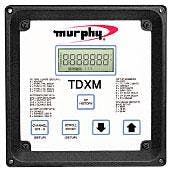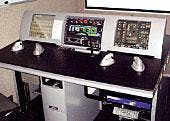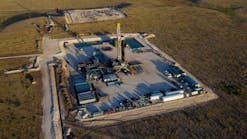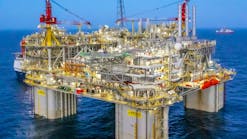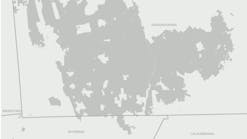Unit monitors compressor, driver, auxiliary equipment
The new TDXM temperature scanner-pyrometer monitors 24 points, each with three adjustable set points. This allows the unit to monitor all the points on a typical compressor, internal combustion engine driver, and auxiliary equipment. The 5 by 5 in. monitor can replace several six or eight point scanners, the maker points out.
Free MConfig software is included with each unit to make setup and monitoring easier and faster.
Designed for gas compression, each of the 24 channels on the unit can be configured as either J or K type thermocouples. Temperature units can be selected as °F. or °C. readout for each channel. Unused channels can be set to "ignore" and will not be seen in the display. This will also help prevent false fault trips from unused channels.
Power is supplied by any 10 to 32 v DC system. The TDXM is designed to meet the requirements for Class I, Division 2, Groups C and D hazardous locations.
A new seven-segment liquid crystal display features 1/2 in. characters. Backlighting helps make reading temperatures and set points easy day or night, the company notes. The unit stores the last set point trip for each output in nonvolatile memory. This fault history may also be displayed.
A built-in RS485 serial communications port allows interface with computers, controllers, and SCADA systems. Discrete outputs allow interface to annunciators.
A deviation from average measurement is a selectable feature. It can be used to monitor cylinders running unusually hot or cold.
Source: FWMurphy, Box 470248, Tulsa, OK 74147.
New application program for reservoir analysis
DecisionSite is a new application program for reservoir analysis.
It's the product of a joint development agreement between Spotfire Inc., Somerville, Mass., and Global Technology Services Co., a unit of ChevronTexaco Corp., San Francisco.
The analytic application is designed to help oil company reservoir managers, petroleum engineers, geologists, and financial specialists with production decisions.
Source: Spotfire Inc., 212 Elm St., Somerville, MA 02144.
New modulator for downhole uses
This new modulator features ultralow power requirements that help suit it for downhole sensing applications.
It promises function integration, wide wavelength coverage, and near-zero insertion loss. The product focuses on solving power, signal, and spectrum management challenges.
Source: Oluma Inc., 5803 Newton Drive, Suite B, Carlsbad, CA 92008.
New system aids seismic interpretation
PowerView for SeisWorks is a newly released integrated visualization and analysis tool.
It allows viewing of 4D seismic, multiple 3D seismic surveys, and seismic attributes concurrently. The PowerView visualization environment enables SeisWorks users to interpret time-lapse 3D seismic and multiattribute data efficiently, the firm notes.
PowerView is built on the traditional map-viewing pattern. Concurrent and interactively linked views of multiple data sets and attribute types provide a step-change in interpretation productivity and accuracy. Interpreters are able to view and interpret reservoir images simultaneously, often revealing geologic relationships not discovered in conventional interpretation workflows, the company says. The interactive, multiwindow visualization environment promises productivity improvement in core SeisWorks interpretation, 4D seismic, and SpecDecomp work flows.
Source: Landmark Graphics Corp., Box 42806, Houston, TX 77242.
Product suite designed to operate submersible units
The Remote Systems Engine (RSE) is a suite of equipment and control software used to perform generic remote systems functions. A photo of the console is shown here.
RSE components can be used on a range of remotely operated submersible systems, including subsea process equipment, wellhead management systems, electrical power conversion systems, trenchers, and plows.
The RSE performs instrument signal acquisition, handling, and logging; video acquisition, recording, and editing; power conditioning and distribution; tool operation and feedback; actuation (electric and hydraulic); electric propulsion; and hydraulic valving and compensation.
Features include:
•Simple, robust equipment that is interfaced to the control system via a network that standardizes and reduces the number of electrical connections.
•Components that are engineered and manufactured to work together in a configurable group.
•Hardware and control software that are modular.
•A design specifically for underwater use.
Source: Alstom Schilling Robotics, 201 Cousteau Place, Davis, CA 95616.
